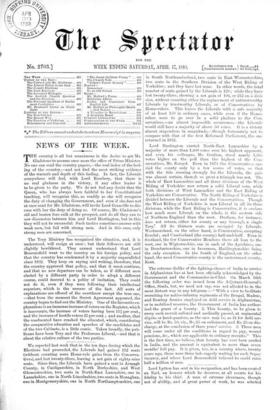Lord Hartington carried North-East Lancashire by a majority of more
than 1,400 votes over his highest opponent, and even his colleague, Mr. Grafton, stood nearly 1,300 votes higher on the poll than the highest of the Con- servatives, Mr. Ecroyd. Even in 1874 the Conservatives car- ried the county only by a few scores of votes, so that with the tide running strongly for the Liberals, the gain was almost certain, though so great a triumph was not. Thu whole of East Lancashire and all three divisions of the West Riding of Yorkshire now return a solid Liberal vote, while both divisions of West Lancashire and the East Riding of Yorkshire are Conservative. The North Riding of Yorkshire is divided between the Liberals and the Conservatives. Though the West Riding of Yorkshire is now Liberal in all its three divisions, while the East Riding is Conservative, it is curious how much more Liberal, on the whole, is the eastern side of Northern England than the west. Durham, for instance, does not return, either for county or any borough, a single Tory: All its thirteen seats are occupied by Liberals. Westmoreland, on the other hand, is Conservative, excepting Kendal; and Cumberland (the county) half-and-half. Even in Scotland, the few Conservative Members there all lean to the west, one in Wigtownshire, one in each of the Ayrshires, one in Dumbartonshire, one in Inverness, Haddingtonshire being the only exception. In the South of England, on the other hand, the most Conservative county is the easternmost county, Kent.


































